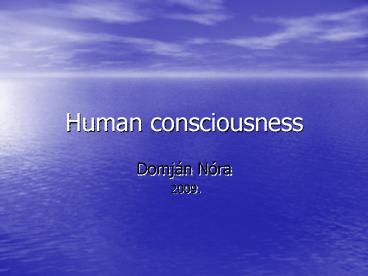Human consciousness - PowerPoint PPT Presentation
1 / 24
Title:
Human consciousness
Description:
Psychedelics. Alternate perception, thought, imagination ... Mixed sedative, psychedelic, or stimulant effects. Cannabis sativa, PCP. Narcotics. Painkillers ... – PowerPoint PPT presentation
Number of Views:643
Avg rating:3.0/5.0
Title: Human consciousness
1
Human consciousness
- Domján Nóra
- 2009.
2
Normal waking consciousness
- Stream of consciousness (we are aware of many
external and internal stimuli at a time) - We can deal only with a few stimulus (attetion
mustnt be distracted) - Which processes help in picking the important
stimuli? ? focusing
3
Subconscious mental activity
- Preconscious
- Can be brought into awareness
- Automatised activities, processes
- Unconscious
- Permanently unaviable for the consciousness
- Physiological functioning
- Processes of thinking and creativity
- Freudian slips
4
Attention
- Consciousness is limited by the selective
attention (can be effortful, directed) - Cocktail party phenomenon dichotic listening
(different infomation into each ear, one must be
shadowed) ? only one source can be remembered - Unattended information is also monitored, so it
can influence behaviour (outstanding stimuli are
understood)
5
Priming
- Undecetable or unprocessed stimuli affect
behaviour, task solving - A stimulus below the treshold of awareness can
accelerate the processing of a conscious
stimulus, if they are related to each other in
some way - E. g. kitten ? xxx ? cat ? decision
- prime ? pause/mask ? (RT measured)
6
- This filtering is automatic and involuntary
- In a complex environment attention can become
effortful, but gets better with time and
practicing - In some situations automatic behaviour can be
regarded as mindless (it results in an unwilled
consequence, e. g. an accident)
7
Sleep and dreams
- We spend almost one third of our lives with
sleeping - The first method to examine brain activity during
sleep has been EEG (electroencephalogram) - Sleep is a multifaceted, patterned and complex
activity
8
Stages of sleep
- Main difference dreams ? NREM and REM (Rapid Eye
Movement) sleep - During NREM phases
- Breathing becomes slow and even
- The heartbeat becomes regular
- Blood pressure falls
- Brain temperature decreases
- Blood flow to the brain is reduced
- Little or no body movement
9
NREM stages
- Stage 1 (ten mins)
- Lightest level of sleep (rather dreamy, than
dream), Low voltage, fast EEG, somewhat irregular - Stage 2 (twenty mins)
- Sleep spindles appear, sleep deepens
- Stage 3
- Delta waves (high voltage, low-frequency), deep
sleep begins - Stage 4
- Deepest sleep, only slow delta activity
10
REM sleep
- Heightened EEG and physiological arousal
- Paradoxical sleep
- Brain and internal organs are highly activated
- Motor neurons are inhibited, so that moving is
impossible - External stimuli are not percieved
- Dreaming
- Returns periodically
11
A nights pattern
12
Stages of awakeness on EEG
13
The need to sleep
- Sleep deprivation
- Few days whithout sleeping does not cause serious
decrease in biological functioning and cognitive
performance - Subjective reports are controversial to
experimental evidence - Circadian rhytm
- Biological clock (25 hours period)
- Evolutional roots
- Energy saving and restoring body tissues
- Safety
14
Sleep disorders
- Insomnia
- Lenghty time to sleep onset
- Frequent wakening
- Early morning wakening
- Causes psychological disorders (anxiety), drugs
- Sleepwalking
- Mostly in childhood
- Narcolepsy
- Sleep attacks during the day
- Cataplexy, sleep paralysis, hypnogogic
hallucinations - Sleep apnea
- Cessation of breathing interrupts sleeping (10
40 secs)
15
Dreams
- Characteristics
- Mostly visual images
- Fantastic, irreal storyline
- Emotion provoking
- Delusional quality
- Dream-deprivation studies
- Subjects awakened at the beginning of REM
- On recovery nights REM phases occur more often
and longer - People need dreaming ? irritabilty
16
Dream theories
- Freud
- Dreams as wish fulfillment
- Uncoscious wishes an be repressed when awake, if
they are not tolerated - Manifest (symbolic) and latent content of dreams
? dream analyses (interpretation) - Hobson and McCarley
- Activation-synthesis hypothesis
- Random brain activation is synthetised by the
cortex into dreams (by-product)
17
Sleep and development
- Sleep may be needed for maturation of brain cells
and consolidation of memories (by newborn 50 of
sleep is REM)
18
Altered states of mind
- Organic
- Sleep
- Psychosis
- Self-induced
- Meditation
- Hypnosis
- Chemical induction
- Psychoactive drugs
19
Meditation
- Focusing on a single, simple image, phrase or
sound reduces the awareness of other external or
internal stimuli - Psychological effects
- Calmness, well-being, which continues into the
daily life - Physiological effects
- Alpha waves dominate brain activity instead of
betas - Decreased breathing and heart rate (reduced
arousal) - Clinical application
- Therapy for stress-related disorders
20
Hypnosis I.
- The suggestions of the hypnotist changes
perception, memory and behaviour (at the extent,
the subject allows) - Hypnotic induction enhances this mental state
- Focused attetion
- Reduced reality testing
- Imaginative involvement
- Hypnotic suggestion
- Hallucinations (positive/negative)
- Memory (amnesia/hypermnesia)
- Behaviour (posthypnotic suggestions)
21
Hypnosis II.
- Hypnotic susceptibility
- Trait (20 highly, 5-10 not at all)
- Can be measured through standardized procedures
- Clinical application
- Working with traumatic memories
- Leuners Guided Affective Imagery Therapy
22
Psychoactive substances I.
- Sedatives
- Decrease activity levels, produce calmness
- Ethyl alcohol, barbiturates, benzodiazepines
- Sedation Intoxication Anesthesia Coma -
Death - Stimulants
- Increase activity levels, enhance positive
feelings, heighten alertness ? euphoria - Caffeine, amphetamines, cocaine (nicotine)
- Rebound ? depression ? repeated usage
- Can trigger psychosis
23
Psychoactive substances II.
- Psychedelics
- Alternate perception, thought, imagination
- LSD, psylocibin, mescaline
- Hallucinations, depersonalisation, memories can
return (therapy?) - Miscellaneous
- Mixed sedative, psychedelic, or stimulant effects
- Cannabis sativa, PCP
- Narcotics
- Painkillers
- Opium, Morphine, Heroin
- Euphoria, drowsiness, nausea
24
(No Transcript)































